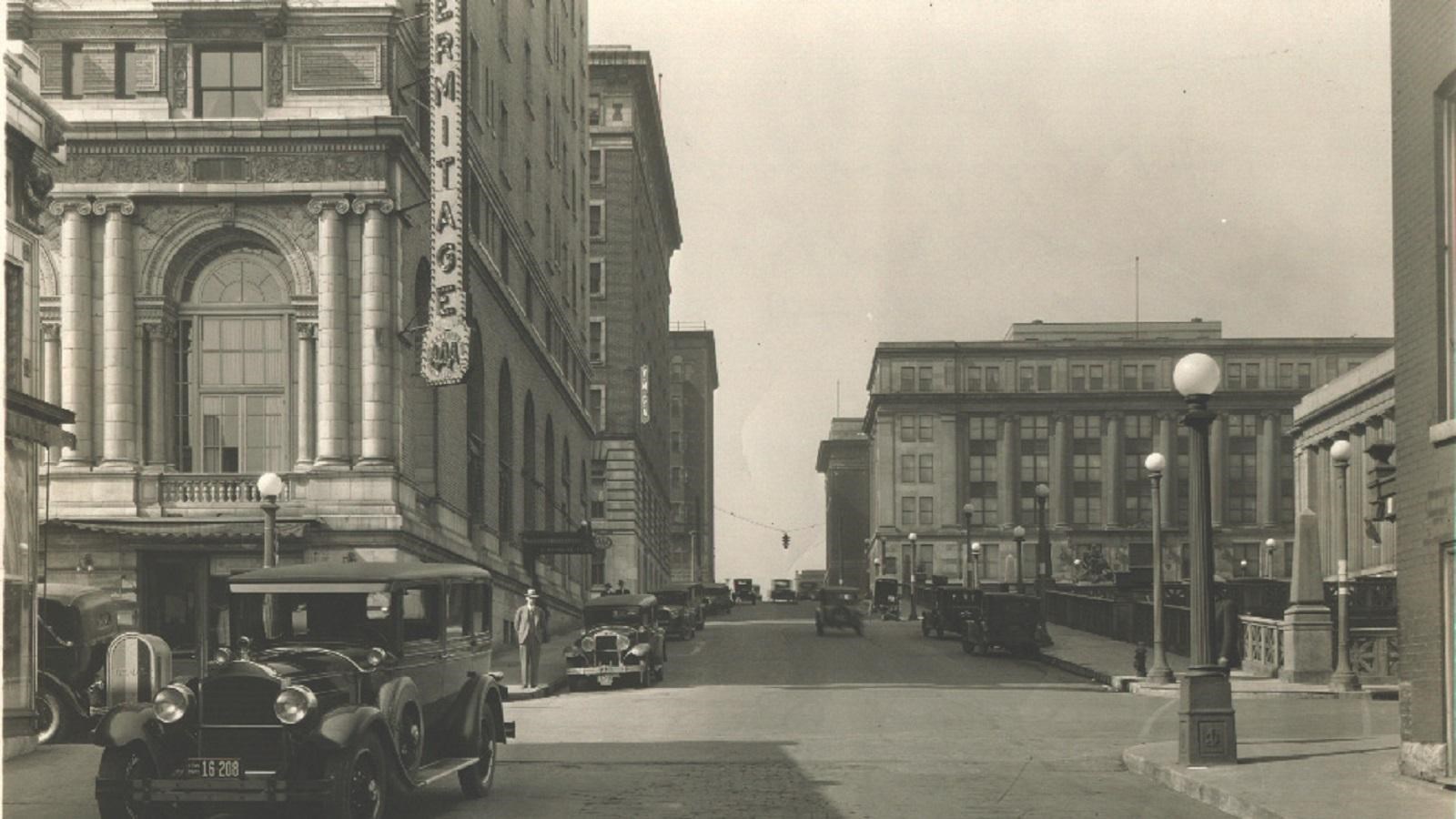Last updated: March 11, 2021
Place
Hermitage Hotel

Courtesy of the Tennessee State Library and Archives, Library Collection, Drawer 18, Folder 211.
The Beaux-Arts style Hermitage Hotel in Nashville, Tennessee is a significant historic site. It is also one of the last buildings of its era remaining in the city’s central district. Located across the street from the state capitol building, the hotel has seen its fair share of political intrigue since it opened in 1910. Most notably, the final drama of the 19th Amendment ratification fight played out here during the summer of 1920.
Suffrage History at the Hermitage
By August of 1920, thirty-five states had ratified the women’s suffrage amendment. Eight had rejected it. One more was needed for it to become law. Tennessee looked like suffragists’ best (and possibly only) hope.
Tennessee would soon convene a special session to vote on the amendment. Pro- and anti-suffrage campaigners descended on Nashville in the summer heat. They set up camp in the elegant Hermitage Hotel, across the street from the capitol building. Carrie Chapman Catt, the president of the National American Woman Suffrage Association (NAWSA), moved into Suite 309. Josephine Pearson, leader of the anti-suffrage forces in Tennessee, also took rooms.
The hotel became the center of the excitement. “Suffs” wore yellow roses, the symbol of the movement, in their lapels. “Antis” sported red ones. Both sides tirelessly lobbied the Tennessee representatives. The hotel lobby became known as the “third house” of the nearby legislature. Carrie Chapman Catt received a steady stream of visitors. Suffragists, local ward officials, and legislators were all eager to talk strategy. Even Tennessee Governor Albert Houston Roberts came to call.
Anti-suffrage lobbyists booked a suite on the eighth floor. In defiance of Prohibition, they were operating it as the hotel’s speakeasy. The lobbyists poured free whiskey and bourbon for pro- and anti-suffrage legislators. Soon the rooms earned the nickname of "Jack Daniel's Suite." As the men got drunker and drunker, they heard more and more persuasive arguments against the 19th Amendment. Prohibition and suffrage had long been linked, and the state's liquor interests strongly opposed women voting.
Josephine Pearson and the “Antis” reserved the elegant mezzanine and first-floor rooms of the hotel to use as a headquarters and event space. Alabama Anti Nina Pinckard even set up a museum exhibit to argue against the amendment. It included copies of what Southerners called the "Force Bills," proposed federal laws that would have protected Black voting rights. The exhibit aimed to stoke racist fears that the 19th Amendment would lead to Black women voting and would threaten the Jim Crow regime in the South. Pinckard and Pearson posed outside the door with a Confederate flag on the day it opened. The exhibit is just one illustration of the powerful role of racism in the suffrage debate. (You can view a photo of Pearson and Pinckard outside the exhibit hall at the bottom of this page.)
As the vote drew closer, the Hermitage Hotel lobby grew more and more tense. Shouting matches and even fistfights broke out. There were reports of special interests on both sides bribing legislators. Carrie Chapman Catt was pretty sure her phone was being tapped, and other suffragists kept catching strange men hanging out around their rooms, trying to eavesdrop.
By August 18, the Tennessee Senate had passed the amendment, but the House still had to vote on it. Everyone knew it would be close. Neither side was sure they had the votes they needed. At first, the vote deadlocked. But at the last minute, something unexpected happened. 24-year-old representative Harry Burn changed his vote to “aye.” It turned out he had a letter in his pocket from his mother, Febb Burn. “Hurrah and vote for suffrage and don’t keep them in doubt,” it read. “Don’t forget to be a good boy and help Mrs. Catt.” Burn decided to listen to his mother.
At the final roll call, pandemonium erupted in the chamber. Back at the Hermitage, Carrie Chapman Catt heard singing and cheering coming closer. She looked out the window and saw a stream of figures—wearing yellow for suffrage—running down the hill to give her the news. The 19th Amendment was ratified by 36 states. This phase of the long and ongoing battle for the woman’s vote was won.
Architecture
The Hermitage Hotel is listed on the National Register of Historic Places. It is an example of Beaux Arts Classicism. The hotel displays many classical details, including Ionic columns and polychrome terra cotta ornamentation. The grand lobby features a painted glass ceiling. During the suffrage campaign, lawmakers and activists gathered in the walnut-paneled Main Dining Room and the Italian Renaissance-style Loggia.
In the 1960s and 1970s Nashville’s downtown experienced disinvestment. The Hotel Hermitage struggled and closed in 1977, two years after being placed on the National Register of Historic Places. The hotel seemed in danger of demolition, but two rounds of restoration in the 1980s and 1990s saved it. It once again operates as a hotel anchoring a revitalizing downtown.
Bibliography
Tennessee4Me. "Showdown in Nashville." The Tennessee State Museum. http://www.tn4me.org/article.cfm/a_id/136/minor_id/56/major_id/20/era_id/6.
National Register of Historic Places, Hermitage Hotel, Nashville, Davidson County, Tennessee, National Register #75001749.
Weiss, Elaine. "Voice in Time: A Fight Against Suffrage." Lapham's Quarterly. April 26, 2018. https://www.laphamsquarterly.org/roundtable/voices-time-womans-hour.
Weiss, Elaine. The Woman's Hour: The Great Fight to Win the Vote. New York: Penguin Books, 2018.
Article by Ella Wagner, Cultural Resources Office of Interpretation and Education.
